Category: Couchbase Autonomous Operator

Announcing Couchbase Server 7.0
Couchbase Server 7.0 solves the requirements of modern application development. In doing so, it settles the debate over using relational or NoSQL databases. There’s no more need to compromise. (Try it out for yourself here or skip straight to the...

4 Patterns for Microservices Architecture in Couchbase
Microservices have emerged as a common architecture pattern over the last decade. In this approach, small, autonomous and loosely coupled services work together over a distributed network. Each microservice is typically delimited to a specific function and business boundary, runs...

Couchbase Autonomous Operator vs MongoDB Enterprise Kubernetes Operator
A Kubernetes Operator is a software extension to Kubernetes that supports built-in capabilities to manage your Kubernetes applications in an automated fashion and that follows Kubernetes principles – especially the Control Loop pattern. Why do we need a Kubernetes Operator?...
![5 Use Cases for Real-Time Prediction Serving Systems with Couchbase [Part 1 of 2]](https://www.couchbase.com/blog/wp-content/uploads/sites/1/2021/07/machine-learning-real-time-prediction-serving-system-with-couchbase-800x280.jpg)
5 Use Cases for Real-Time Prediction Serving Systems with Couchbase [Part 1 of 2]
Every machine learning use case has different performance needs, and when it comes to ML-powered enterprise prediction serving systems, it’s no different. A machine learning (ML) model takes an input (e.g., an image) and makes a prediction about it (e.g.,...

How to Build a Couchbase Autonomous Operator Proof of Concept
Whenever I hear about a customer’s first experience with the Couchbase Autonomous Operator (CAO) for Kubernetes, their first question tends to be “How much?” The answer is that it’s already included in their Enterprise Edition subscription. Joyous to hear this,...

Navigating Kubernetes Vulnerabilities with the Autonomous Operator
The first critical vulnerability in the Kubernetes container orchestration platform was disclosed earlier this month. This vulnerability affects all versions of Kubernetes greater than 1.0.0. It also affects RedHat OpenShift platform versions greater than 3.0.0. In this post we look...